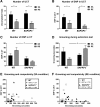Evidence for Distinct Forms of Compulsivity in the SAPAP3 Mutant-Mouse Model for Obsessive-Compulsive Disorder
- PMID: 32234806
- PMCID: PMC7189488
- DOI: 10.1523/ENEURO.0245-19.2020
Evidence for Distinct Forms of Compulsivity in the SAPAP3 Mutant-Mouse Model for Obsessive-Compulsive Disorder
Abstract
The specific mechanisms underlying compulsive behavior in obsessive-compulsive disorder (OCD) are unknown. It has been suggested that such compulsivity may have its origin in cognitive dysfunction such as impaired processing of feedback information, received after the completion of goal-directed actions. The signal attenuation (SA) task models such a processing deficit in animals by attenuating the association strength between food reward and audiovisual feedback (signal) presented after performance of an operant response. The compulsive-like responding resulting from SA is well characterized in rats, but was so far not established in mice, a species for which powerful genetic OCD models exist. Thus, first, we demonstrate that the SA task can be implemented in mice and show that attenuation of reward-associated response feedback produces similar behavior in C57BL/6 mice as previously reported in rats. Second, we tested the hypothesis that SAPAP3 knock-out mice (SAPAP3-/-), prone to exhibit several OCD-like abnormalities including excessive grooming, show enhanced compulsive-like behavior in the SA task compared with their wild-type (WT) littermates. However, task-related compulsivity measures in SAPAP3-/- and WT did not yield significant differences, neither following SA nor during "regular" extinction of operant behavior. Thus, compulsive-like instrumental behavior following feedback distortion was not potentiated in compulsively grooming mice, implicating specifically that (1) a general deficit in feedback processing is not related to excessive grooming in SAPAP3-/- and (2) different manifestations of compulsivity may be driven by independent mechanisms.
Keywords: SAPAP3 knock-out mice; compulsivity; feedback processing; obsessive-compulsive disorder; signal attenuation.
Copyright © 2020 Ehmer et al.
Figures





References
-
- American Psychiatric Association (2013) Diagnostic and statistical manual of mental disorders, Ed 5 Washington, DC: American Psychiatric Association.
-
- Chamberlain SR, Blackwell AD, Fineberg NA, Robbins TW, Sahakian BJ (2005) The neuropsychology of obsessive compulsive disorder: the importance of failures in cognitive and behavioural inhibition as candidate endophenotypic markers. Neurosci Behav Rev 29:399–419. 10.1016/j.neubiorev.2004.11.006 - DOI - PubMed
Publication types
MeSH terms
Substances
LinkOut - more resources
Full Text Sources
Medical
Molecular Biology Databases
